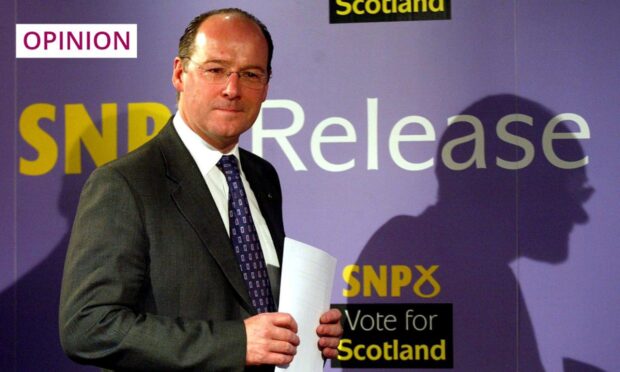I think Bud Askins from Amazon Prime’s Fallout – the hit sci-fi doomsday TV drama – summed it up better than most.
He wasn’t talking specifically about the SNP’s latest catastrophic meltdown, but it kind of fits the Humza Yousaf crisis.
For those who don’t know Mr Askins or Fallout, here’s a brief summary.
The end of the world has occurred, with numerous nuclear bombs going off. Humans who survived the blasts fall into two categories.
Political and social elites who saw this coming retreated long ago with their followers into bunkers deep underground, to build a weird, new, subterranean world. Free and unfettered, their regimes pursue all kinds of ideological theories – some good, many bad.
Completely cut off in their own bubbles and disconnected from those less privileged who are still in the real world. Is this starting to sound familiar?
Meanwhile, back on the surface, wretched radiation-soaked survivors are a mix of mutants, ghouls and wild, feral people trying to kill each other all the time. (I hope you don’t mind, but this will have to work as a metaphor for us, the general public.)
Bud Askins was the corporate brain behind the supposedly safe bunkers, or “vaults”, as they were known. Vault bosses could test favourite wacky theories on citizens who sheltered under their banners.
Dare I say – after the SNP-Greens mutant experiment which destroyed Yousaf – that various unwise coalitions were formed.
Bud was quite brutal with doubters among business and investment partners who worried about vault-dwellers being deposed by the deranged mob above (the public, that is). “What is the most effective weapon of mass destruction?” He asked them.
With a pause for dramatic effect, he answered the question himself, of course. “It’s time. Time is the apex of destruction,” he proclaimed. “Time will destroy all our enemies.”
In other words, bide your time until your foes give up or die off.
So, there you have it – an allegory for modern political life, it might seem.
Time can be a double-edged sword
Downtrodden families come to mind, on the receiving end of unjust raw deals after political scandals involving contaminated blood, postmasters and the Waspi pension women. They must suspect the government hopes they die off in time.
In Scotland – divided bitterly over independence – many must feel they are being battered into submission by those who believe if they keep it up for long enough, they will prevail, with time on their side. Promising a new era on becoming the country’s leader, Yousaf simply picked up Nicola Sturgeon’s broken, splintered battering ram and carried on as normal.
Time might be a powerful weapon, but it also sows dissatisfaction. Just look at slow-moving public inquiries – such as Iraq, Covid and Horizon – where memories are supposedly dimmed by the passage of time, and the spinning wheel of blame finds it hard to come to rest anywhere.
But, as Yousaf discovered, time is also a double-edged sword. Eventually, a day of reckoning comes.
As a prominent SNP adviser told me during the 2014 referendum: in time, the party would stand or fall on its domestic record.
So, after almost two decades of making not much difference, the SNP is sharing the same leaky boat as Sturgeon’s “I detest” Tories, with another unelected first minister.
Former Welsh leader Mark Drakeford made a good point when asked about Yousaf’s leadership exit. Drakeford commented that leaders have to “get on with it because it won’t last”.
A ‘new era’? Time will tell
Gliding in on a paper aeroplane as continuity pilot – with a divisive, wafer-thin leadership majority – Yousaf never got out of first gear after the mess Sturgeon left behind and constant doubts about his judgment. I wrote at the time that he was the wrong choice, and that Highlander Kate Forbes was a better bet, if the SNP fancied a brave and genuine “new era”.
Like many leaders who can’t quite believe what just happened, Yousaf sounded faintly deluded.
Perhaps Kate Forbes is keeping her powder dry until potential election carnage ahead has subsided
Oddly, he claimed he was “frustratingly close” to independence, when the SNP were actually as far away as ever; bewildered by the “toxicity” of Scottish politics, when he and Sturgeon were part of stoking it.
But, at least he came to his senses and realised that tawdry deals with the Scottish Greens or Alex Salmond’s Alba Party were never credible.
The trouble with prospective first minister John Swinney is that he is an old-guard establishment figure, prominent in previous Salmond and Sturgeon administrations as their right-hand man. His own party leadership stint 20 years ago wasn’t covered in glory, and he was in charge of the infamous proposed named person policy, likened to a “totalitarian state” by judges.
Now, Swinney is being anointed like Rishi Sunak – another thing in common with the Tories (unless a late rival appears).
Perhaps Kate Forbes is keeping her powder dry until potential election carnage ahead has subsided.
Meanwhile, she wants to inject “courtesy and dignity” into politics from the top – at long last. Time will tell.
David Knight is the long-serving former deputy editor of The Press and Journal



Conversation